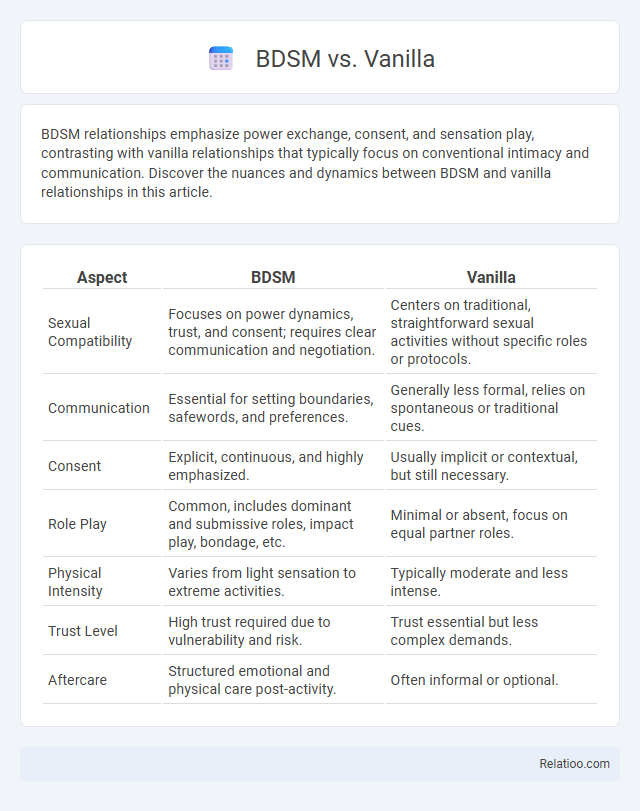BDSM relationships emphasize power exchange, consent, and sensation play, contrasting with vanilla relationships that typically focus on conventional intimacy and communication. Discover the nuances and dynamics between BDSM and vanilla relationships in this article.
Table of Comparison
| Aspect | BDSM | Vanilla |
|---|---|---|
| Sexual Compatibility | Focuses on power dynamics, trust, and consent; requires clear communication and negotiation. | Centers on traditional, straightforward sexual activities without specific roles or protocols. |
| Communication | Essential for setting boundaries, safewords, and preferences. | Generally less formal, relies on spontaneous or traditional cues. |
| Consent | Explicit, continuous, and highly emphasized. | Usually implicit or contextual, but still necessary. |
| Role Play | Common, includes dominant and submissive roles, impact play, bondage, etc. | Minimal or absent, focus on equal partner roles. |
| Physical Intensity | Varies from light sensation to extreme activities. | Typically moderate and less intense. |
| Trust Level | High trust required due to vulnerability and risk. | Trust essential but less complex demands. |
| Aftercare | Structured emotional and physical care post-activity. | Often informal or optional. |
Understanding BDSM: Core Concepts and Practices
BDSM encompasses Bondage, Discipline, Dominance, Submission, Sadism, and Masochism, focusing on consensual power exchange and sensation play that emphasizes trust and communication. Unlike Vanilla relationships, which involve conventional sexual and emotional interactions, BDSM prioritizes negotiated boundaries and often incorporates role-playing, restraints, and impact play. Your understanding of BDSM deepens by recognizing its fundamental practices, including safe words, aftercare, and explicit consent as pillars ensuring a safe and fulfilling experience.
Defining Vanilla Relationships
Vanilla relationships are characterized by conventional, traditional intimacy and sexual activities without the inclusion of BDSM or fetish elements. These relationships prioritize emotional connection and standard expressions of affection, often aligning with societal norms and expectations. While BDSM involves power dynamics and consensual kink, and fetish relationships focus on specific objects or scenarios for arousal, vanilla relationships emphasize straightforward, everyday romance and physical intimacy.
Key Differences Between BDSM and Vanilla Dynamics
BDSM involves consensual power exchange, role-playing, and a focus on physical and psychological sensations beyond typical sexual activities, while vanilla dynamics refer to conventional sexual interactions without kink elements. Vanilla partners typically engage in standard intimacy practices emphasizing emotional connection, whereas BDSM participants prioritize negotiated boundaries, trust, and rituals such as bondage or dominance/submission. Fetishism centers on specific objects or body parts as sexual arousal triggers, distinct from the broader lifestyle roles and power structures in BDSM and the normative preferences in vanilla relationships.
Communication and Consent in Both Worlds
Effective communication and explicit consent form the cornerstone of both BDSM and vanilla relationships, ensuring mutual understanding and respect for boundaries. In BDSM communities, detailed negotiations about limits, safe words, and aftercare protocols are routine to establish trust and maintain safety. Vanilla partners also require open dialogue about desires and comfort levels, while fetish dynamics often emphasize clear expression of specific interests and enthusiastic consent to create fulfilling experiences.
Safety Practices: BDSM vs Vanilla Sex
BDSM safety practices emphasize clear communication, consent, and the use of safe words to prevent physical and emotional harm, setting it apart from vanilla sex where boundaries might be less explicitly negotiated. Your well-being in BDSM relies on thorough knowledge of risks, aftercare techniques, and trust between partners, while vanilla sex typically involves more straightforward interactions without specialized precautions. Understanding these distinctions ensures safer, more fulfilling experiences tailored to your preferences and needs.
Emotional Intimacy: Contrasts and Parallels
BDSM, Vanilla, and Fetish relationships each cultivate emotional intimacy through unique dynamics: BDSM often emphasizes trust and vulnerability through negotiated power exchange, Vanilla prioritizes traditional romantic connection and comfort, while Fetish relationships center around shared specific desires that can deepen emotional bonds. Your emotional intimacy in any of these contexts depends on open communication, consent, and mutual understanding, which build lasting connection regardless of the relationship style. Despite their differences, all three foster emotional closeness by aligning partners' needs and boundaries to create meaningful experiences.
Myths and Misconceptions about BDSM and Vanilla
BDSM is often misunderstood as abusive or inherently harmful, while vanilla relationships are mistakenly viewed as boring or lacking intimacy; both stereotypes overlook the consensual and communicative foundations crucial to all relationship types. Myths about BDSM include the belief that it is only about pain or domination, ignoring the emphasis on trust, negotiation, and mutual pleasure integral to safe practices. Misconceptions about vanilla relationships involve underestimating the diversity of emotional connection and sexual satisfaction they can offer, demonstrating that the boundaries between BDSM, fetish, and vanilla are highly individual and fluid.
Exploring Sexual Boundaries and Preferences
Exploring sexual boundaries and preferences involves understanding the distinct dynamics of BDSM, vanilla, and fetish practices. BDSM emphasizes power exchange, sensation play, and consent-driven activities, appealing to those seeking intense physical and psychological experiences beyond vanilla sex's more traditional intimacy and emotional connection. Fetish focuses on specific objects or scenarios that trigger sexual arousal, allowing you to tailor your desires and expand your sexual repertoire with personalized stimulation.
Navigating Compatibility: Mixing BDSM with Vanilla
Navigating compatibility between BDSM and vanilla relationships requires clear communication and mutual understanding of boundaries and desires. Incorporating BDSM elements into a primarily vanilla dynamic involves discussing comfort levels, safe words, and consent to ensure both partners' needs are respected. Successful mixing fosters trust and allows exploration of fantasies while maintaining emotional safety and connection.
Embracing Diversity in Sexual Lifestyles
BDSM, vanilla, and fetish represent diverse sexual lifestyles that highlight the importance of embracing individual preferences and boundaries. Understanding these variations promotes respect and open-mindedness toward Your partner's desires and limits, fostering healthier and more fulfilling relationships. Celebrating this diversity encourages communication and consent, essential components for safe and enjoyable intimate experiences.

Infographic: BDSM vs Vanilla
 relatioo.com
relatioo.com